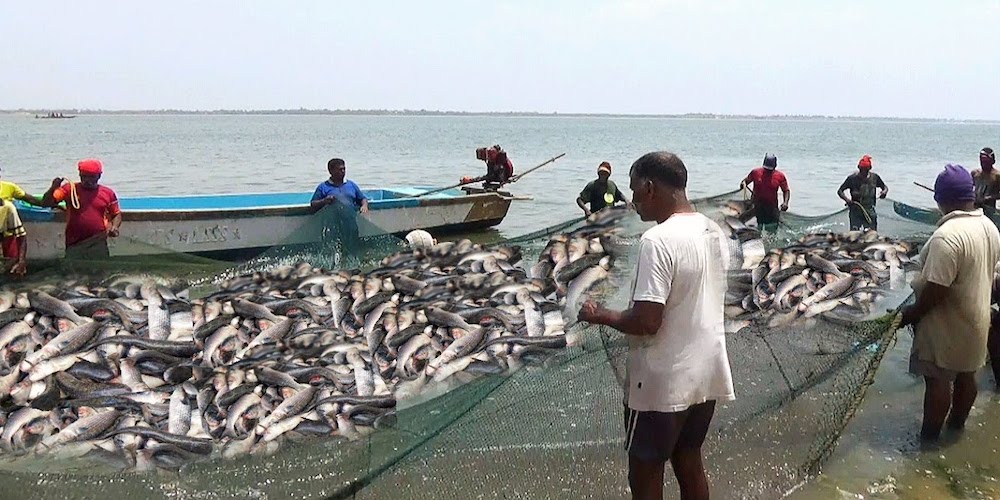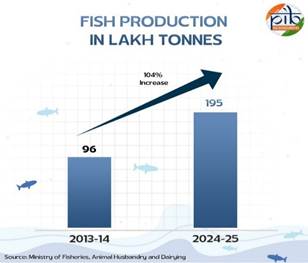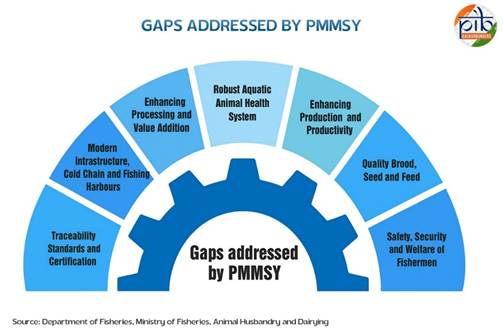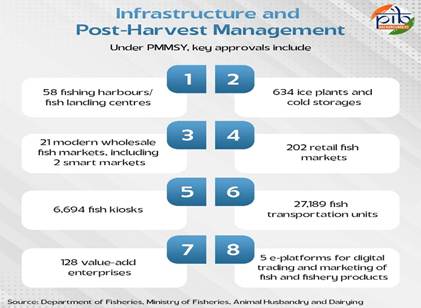Harnessing Fisheries

Fish production has grown by 104% from 96 lakh tonnes in 2013–14 to 195 lakh tonnes in 2024–25
India stands as the second largest fish producing nation in the world, contributing around 8% of global output. The sector is a key source of food, jobs and income for millions of families, particularly in coastal and rural areas. Over the last decade it has undergone a major transformation in both scale and method.
The Modi government has recently releases a report for the press that says that from 2013-14 to 2024-25, the country’s total fish production has grown by an impressive 104% comprising both marine and inland sectors.
Output has increased from 96 lakh tonnes to 195 lakh tonnes. Much of this growth has come from inland fisheries, which have expanded by 142% in the same period. Production in this segment has risen from 61 lakh tonnes to 147.37 lakh tonnes.

This change reflects a move towards modern, sustainable and high-yield aquaculture. Better technology, improved infrastructure and stronger value chains have helped farmers produce more and earn more.
Investments in hatcheries, pond systems, cold chains and market networks have allowed fish to reach consumers faster and in better condition. The result is a stronger sector that feeds more people and supports more livelihoods than ever before.
Incidentally, the Union Budget 2025-26, proposed the highest ever total annual budgetary support of Rs. 2,703.67 crores for the fisheries sector, strengthening what is called the Blue economy.
In fact, the Blue Revolution began in 2015 with the aim of increasing fish production and improving the fisheries value chain across inland and marine sectors. It focused on raising productivity, expanding infrastructure, and bringing modern practices to fishers and fish farmers.
Over time, critical gaps remained in areas such as post-harvest handling, traceability, welfare of fishers, and formal linkages to credit and markets.
To address these gaps and accelerate the transformation, the Government launched the Pradhan Mantri Matsya Sampada Yojana in 2020. The new programme builds on the gains of the Blue Revolution and extends its reach with greater depth and convergence.
Sectoral Components and Programmes
1. The Pradhan Mantri Matsya Sampada Yojana
Pradhan Mantri Matsya Sampada Yojana has been created to fill important gaps in India’s fisheries sector. It works to improve fish production and productivity, raise quality standards, bring in modern technology, strengthen post-harvest infrastructure and ensure better management. The scheme also focuses on building a stronger value chain, improving traceability, creating a sound fisheries management system and ensuring the welfare of fishers.

2. Pradhan Mantri Matsya Kisan Samridhi Sah Yojana
The Pradhan Mantri Matsya Kisan Samridhi Sah-Yojana (PM-MKSSY) is a Central Sector Sub-scheme under the Pradhan Mantri Matsya Sampada Yojana (PMMSY). It was approved by the Union Cabinet in February 2024 and is being implemented across all States and Union Territories for a four-year period from 2023-24 to 2026-27 with an estimated financial outlay of ₹6,000 crore. As of April 2025, ₹11.84 crore has already been sanctioned under the scheme to support early implementation.
PM-MKSSY is designed to address the long-standing structural challenges in the fisheries sector. It brings in a mix of financial and technological interventions, backed by institutional reforms. The scheme supports the long-term transformation of the fisheries ecosystem by promoting formalisation, insurance coverage, access to finance, and quality assurance across the value chain.
3. National Fisheries Digital Platform (NFDP)
The Department of Fisheries under the Ministry of Fisheries, Animal Husbandry and Dairying launched the National Fisheries Digital Platform (NFDP) on 11 September 2024. This digital platform has been developed under the Pradhan Mantri Matsya Kisan Samridhi Sah-Yojana (PM-MKSSY).
The platform aims to formalise the fisheries and aquaculture sector by creating work-based digital identities for all stakeholders. It is also building a centralised database of fishers, fish farmers, cooperatives, enterprises and other value chain actors.
NFDP acts as a single-window platform that helps beneficiaries access institutional credit, aquaculture insurance, traceability systems and performance-linked incentives. It also supports the strengthening of fisheries cooperatives and provides training and capacity-building opportunities.
4. Fisheries and Aquaculture Infrastructure Development Fund
The Fisheries and Aquaculture Infrastructure Development Fund was first announced in the Union Budget of 2018. It was formally launched in 2018–19 by the Department of Fisheries. The fund was created to strengthen infrastructure across marine and inland fisheries. The total fund size is ₹7,522.48 crore.
To continue this momentum, the Government extended the FIDF scheme for three more years, from April 2023 to March 2026. During this extended period, a credit guarantee facility is being provided using the existing fund from the Animal Husbandry Infrastructure Development Fund (AHIDF).
The scheme offers a credit guarantee cover of up to ₹12.50 crore, helping fishers and entrepreneurs access much-needed credit with lower financial risk. It also provides an interest subvention of up to 3% per year under the FIDF. This support helps Nodal Loaning Entities offer concessional finance at a minimum interest rate of 5% per year.
Recent Achievements in Fisheries Infrastructure and Investments
As of 29 July 2025, the Department of Fisheries has supported infrastructure projects under the Pradhan Mantri Matsya Sampada Yojana with a total outlay of ₹17,210.46 crore. Out of this, ₹6,761.80 crore has come from the central share.

Fisheries Clusters
The Department has officially notified 34 fisheries clusters across the country. This includes dedicated organic fisheries clusters in Sikkim and Meghalaya, encouraging environmentally sustainable practices.
Integrated Aquaparks serve as comprehensive hubs for fisheries activities. These parks are designed to strengthen every link in the aquaculture value chain. They offer complete infrastructure support starting from fish seed and feed, to farming services, processing, cold storage and access to markets. These parks bring efficiency through cluster-based development. They help reduce post-harvest losses and ensure higher incomes for farmers through value addition and organised marketing.
Support for Startups and Innovation
In a significant step to bring innovation into the sector, the Department is supporting fisheries startups under the PMMSY. Through collaboration with Startup India, startups receive:
• Seed funding
• Incubation support
• Guidance to improve productivity and market access
So far, 39 startup project proposals have been approved with a total subsidy support of ₹31.22 crore under the Entrepreneur Model of PMMSY Scheme.
As of July 2025, 163 new project proposals from various States, Union Territories and private entrepreneurs have been approved. These projects have a total cost of ₹6,273.31 crore. Of this, ₹4,209.05 crore has been set aside specifically for interest subvention support.
5. Kisan Credit Card for Fisheries
The Kisan Credit Card (KCC) has emerged as a critical tool in ensuring financial inclusion for farmers across India. Designed to provide quick and easy access to working capital, the KCC enables farmers to purchase inputs like seeds, fertilisers and pesticides, and meet cash needs related to crop production and allied activities.
Since 2019, the scheme has been extended to cover animal husbandry, dairy and fisheries, making it inclusive for allied sectors as well.
6. Dharti Aaba Janjatiya Gram Utkarsh Abhiyan
Dharti Aaba Janjatiya Gram Utkarsh Abhiyan, also known as DA‑JGUA, is the largest tribal development mission in India. It focuses on socio‑economic upliftment of over five crore tribal people across 63,843 villages, 549 districts, and 2,911 blocks. 17 Ministries work together under this scheme for integrated development.
The scheme aligns fisheries interventions with Pradhan Mantri Matsya Sampada Yojana to ensure asset creation, technical support, and market linkages for tribal communities.
Thus, one can say that India’s fisheries sector is undergoing a major transformation through strong policy support, modern technologies, and inclusive initiatives. Schemes like PMMSY and PM-MKSSY are boosting production, improving infrastructure, and empowering fishers, especially women and tribal communities. With innovations like RAS, Biofloc, smart harbours, and digital platforms, the sector is becoming more sustainable and efficient. These efforts are not only enhancing livelihoods but also contributing to food security and the national economy. The way forward is to build on this momentum for long-term, inclusive growth.


